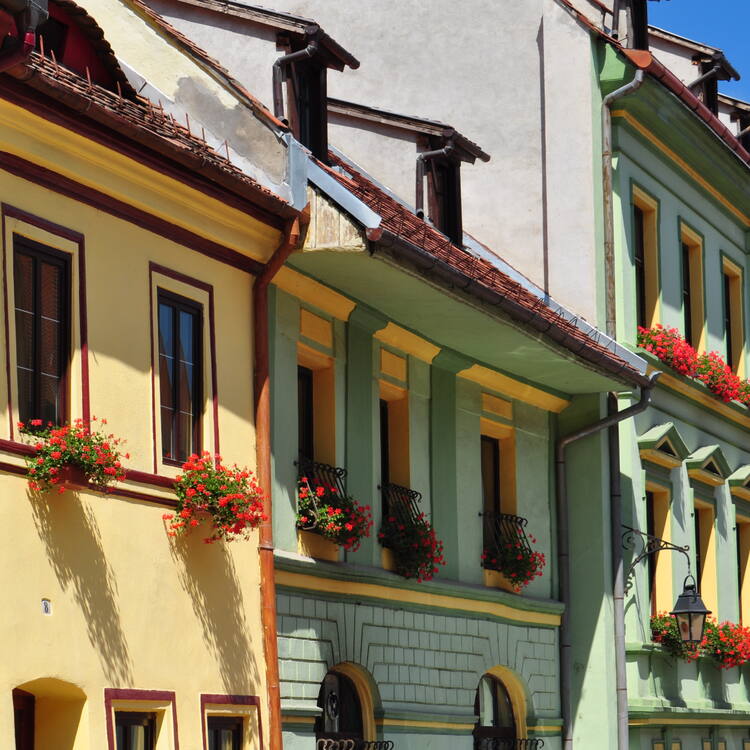Historic Centre of Sighişoara
Historic Centre of Sighişoara
Founded by German craftsmen and merchants known as the Saxons of Transylvania, Sighişoara is a fine example of a small, fortified medieval town which played an important strategic and commercial role on the fringes of central Europe for several centuries.
Description is available under license CC-BY-SA IGO 3.0
Centre historique de Sighişoara
Fondé par des artisans et des marchands allemands, appelés Saxons de Transylvanie, le centre historique de Sighisoara a gardé de manière exemplaire les caractéristiques d’une petite ville médiévale fortifiée qui a eu pendant plusieurs siècles un rôle stratégique et commercial notable aux confins de l’Europe centrale.
Description is available under license CC-BY-SA IGO 3.0
وسط سيغيسوارا التاريخي
تأسس هذا الوسط التاريخي على يد حرفيين وتجار ألمان يعرفون باسم ساكسون ترانسلفانيا، وقد حافظ بصورة نموذجية على خصائص مدن القرون الوسطى الصغيرة المحصنة التي اضطلعت على مر العصور بدور استراتيجي وتجاري مرموق على حدود اوروبا الوسطى.
source: UNESCO/CPE
Description is available under license CC-BY-SA IGO 3.0
锡吉什瓦拉历史中心
锡吉什瓦拉历史中心由德国工匠和商人所建,以特兰西瓦尼亚撒克逊闻名于世。锡吉什瓦拉历史中心保留了中世纪防卫小城的原貌,几个世纪以来,它在中部欧洲的政治、贸易方面,发挥着极其重要的作用。
source: UNESCO/CPE
Description is available under license CC-BY-SA IGO 3.0
Исторический центр города Сигишоара
Основанная немецкими ремесленниками и торговцами, известными как «трансильванские саксонцы», Сигишоара является прекрасным примером укрепленного средневекового города, который играл важную стратегическую и торговую роль на окраине Центральной Европы в течение нескольких столетий.
source: UNESCO/CPE
Description is available under license CC-BY-SA IGO 3.0
Centro histórico de Sighişoara
Fundada por los llamados sajones transilvanos –artesanos y mercaderes alemanes–, esta ciudad ha conservado admirablemente su centro histórico, característico de las pequeñas ciudades medievales fortificadas. Durante varios siglos, Sighişoara desempeñó un importante papel estratégico y comercial en los confines de la Europa Central.
source: UNESCO/CPE
Description is available under license CC-BY-SA IGO 3.0
シギショアラ歴史地区
ルーマニア中部、ムレシュ州の州都。トランシルヴァニアの位置上の中心地。1191年「トランシルヴァニアのザクセン人」として知られるドイツの職人や承認の入植に始まる。15~16世紀の全盛期には15ものギルドをもつ城塞都市であり、中央ヨーロッパの重要な商業的役割を担った。町のシンボルである時計台は14世紀のもの。山上教会(14世紀建立)などに入植以来のドイツ人の影響の濃さが見られる。今なお中世の面影を色濃く残す落ちついた町である。source: NFUAJ
Historisch centrum van Sighişoara
De historische stad Sighişoara ligt in het hart van Transsylvanië en wordt gedomineerd door een heuvel met uitzicht op de Tirnava rivier. Sighişoara werd gesticht door Duitse ambachtslieden en handelaren, bekend als de Saksen van Transsylvanië. De stad is een goed voorbeeld van een kleine versterkte stad in het grensgebied tussen de Latijns georiënteerde cultuur van Centraal-Europa en de Byzantijns-orthodoxe cultuur van Zuidoost-Europa. Sighişoara speelde gedurende enkele eeuwen een belangrijke strategische en commerciële rol in Centraal-Europa. De middeleeuwse stad weerspiegelt de cultuur van de Transsylvanische Saksen, die na 850 jaar tot een einde kwam en alleen is blijven voortbestaan door zijn architecturale en stedelijke monumenten.
Source: unesco.nl
Justification for Inscription
Criterion (iii): Sighisoara is an outstanding testimony to the culture of the Transylvanian Saxons, a culture that is coming to a close after 850 years and will continue to exist only through its architectural and urban monuments.
Criterion (v): Sighisoara is an outstanding example of a small fortified city in the border region between the Latin-oriented culture of central Europe and the Byzantine-Orthodox culture of south-eastern Europe. The apparently unstoppable process of emigration by the Saxons, the social stratum which had formed and upheld the cultural traditions of the region, threatens the survival of their architectural heritage as well.


